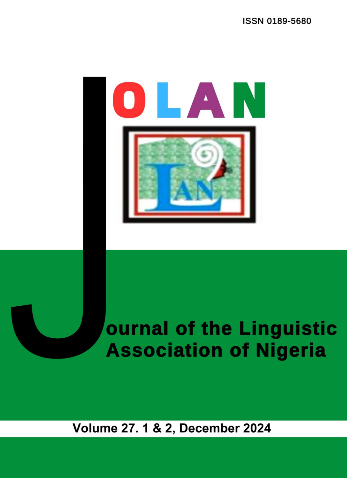Morphosyntactic Analysis of Fulfulde Voice and Tense in Adamawa Dialect: A Case Study of Yola South
Keywords:
Fulfulde Dialects, Language Change, Fulfulde Morphology, Voice and TenseAbstract
Voice is a relationship between subject and object with reference to verb in a sentence. Fulfulde verbs have three types of voices: active voice, middle voice and passive voice. The three voices also mark tenses such as past, present, habitual and future. In Fulfulde language, voices are attached with tenses and marked on verbs. This paper intends to look at the voice and tense affixes that are attached to verbs, with the aim to identify which affixes are frequently used, which are less frequently used and which are not used in today Adamawa dialect. The paper will then describe the productivity of these affixes and how some are lost over time, which is probably an evidence of ‘language change in progress’.
References
Abba, A. (2003). History of Yola (1809-1914). Zaria. Ahmadu Bello University Press.
Ahmed, A, I. (2011). Introduction to Fulfulde Syntax. LINCOM EUROPA, Academic Publications.
Aminu, A. (2015). Comparative Study of Hausa and Fulfulde Inflections. Unpublished M.A Thesis. Zaria. Department of African Languages and Cultures, Ahmadu Bello University.
Aminu, A. (2016). Comparative Study of Fulfulde and Swahili Noun Classes. Kano. 2nd International Conference on Fulfulde Studies. Centre for Research in Nigerian Languages and Folklore, Bayero University, Kano.
Arnott, D.W. (1956). The Middle Voice in Fula. Bulleting of the School of Oriental and African Studies, University of London, Vol. 18 No. 1. Cambridge University Press.
Arnott, D.W. (1970). Nominal and Verbal Systems of Fula. Oxford. Clarendon press.
Arnott, D.W. (1974). Some Aspects of the Study of Fula Dialects. London. Bulleting of the School of Oriental and African Studies. Vol. 37, No 1. Cambridge University Press.
Daudu, G.K. (2008). Morphological Processes in Fulfulde, Harsunan Nijeriya.
Girei, A.U. (1999). A Comparative Analysis of Morphosyntactic Variations Between Adamawa and Gombe Dialects of Fulfulde. M.A Thesis, Department of Languages and Linguistics, University of Maiduguri, Nigeria.
Goshe, S.M. (2016). The Lexical Dialectal Variations Between Sokoto and Adamawa Dialect of Fulfulde Language. Kano. 2nd International Conference on Fulfulde Studies. Centre for Research in Nigerian Languages and Folklore, Bayero University, Kano.
Greenberg, J.H (1963). The Languages of Africa. Indiana University, Bloomington, Mouton, The Hague.
Labov, W. (2007). Transmission and Diffusion. Language, vol.8 no 2. Linguistic Society of America. Stable URL: http://www.jstor.org/stable/40070845
Lyons, J. (2009). Language and Linguistics. Cambridge. Cambridge University Press.
McIntosh, M. (1984). Fulfulde Syntax and Verbal Morphology. St Edmundsbury Press Ltd.
Mukoshy, I. (1991). Fulfulde Morphemes. In: Abba, I.A. Mukoshy, I. and Tahir, G. (Eds) Studies in Fulfulde Language, Literature and Culture, Proceedings of the 1st – 4th International Conferences on Fulfulde Language, Literature and Culture. Kano: Centre for the Study of Nigerian Languages, Bayero University.
Mukoshy, I. A. (1984). The sounds and Morphemes of Fulfulde: An Examination of Fulfulde Phonology and Morphology. Unpublished. PhD Dissertation. Khartoum: Institute of African and Asian Studies, University of Khartoum.
Pelletier, C. A. and Skinner, A. N. (1981). Adamawa Fulfulde: An Introductory course. Department of African languages and Literature. Madison: University of Wisconsin-Madison.
Usman, B. Bello, M.I, Muhammad, A.A. (2016). The Emerging Variety of Adamawa Dialect of Fulfulde. Kano. 2nd International Conference on Fulfulde Studies. Centre for Research in Nigerian Languages and Folklore, Bayero University, Kano.
Yule, G. (1991) The Study of Language. Cambridge. The Bath Press Avon.














